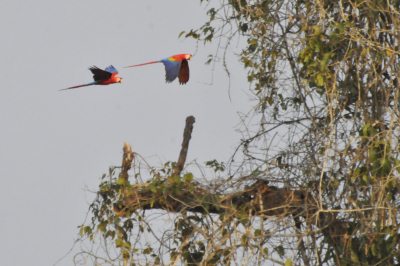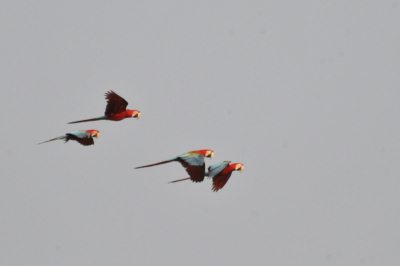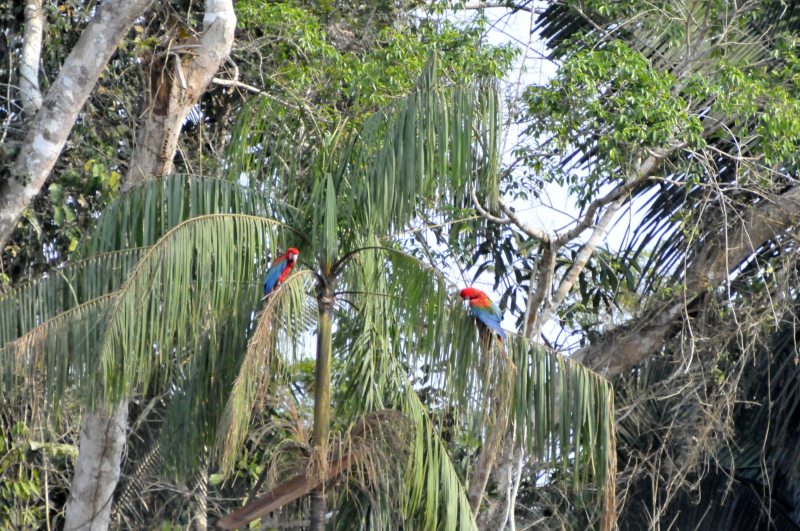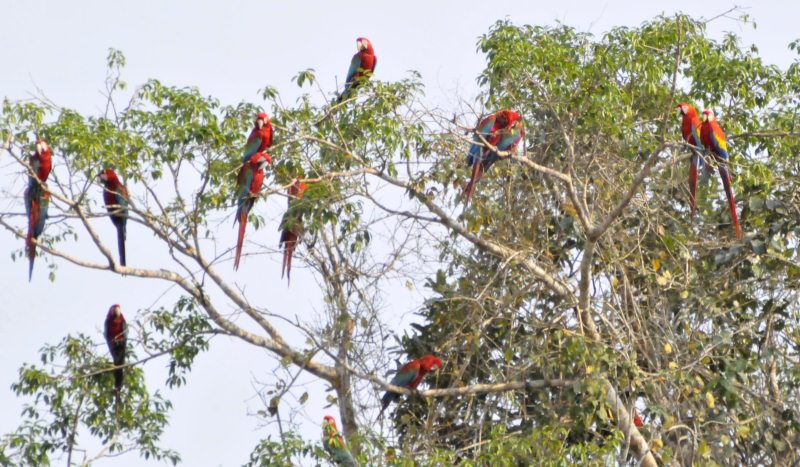Macaws

|
Macaws
  Macaws are small to large, mostly colourful New World parrots. Of the many different Psittacidae (true parrots) genera, six are classified as macaws: Ara, Anodorhynchus, Cyanopsitta, Primolius, Orthopsittaca, and Diopsittaca. Macaws are native to Mexico, Central America, South America, and we saw our first blue and yellow macaw in the Nariva Swamp, Trinidad. Most species are associated with forest, especially rainforest, but others prefer woodland or savannah-like habitats.   Large, dark (usually black) beaks, and relatively bare, light coloured, medial (facial patch) areas distinguish macaws. Sometimes the facial patch is smaller in some species and limited to a yellow patch around the eyes and a second patch near the base of the beak in the members of the genus Anodorhynchus, or Hyacinth Macaw. A macaw's facial feather pattern is as unique as a fingerprint. Macaws, like parrots, toucans and woodpeckers, are zygodactly, having their first and fourth toes pointing backwards.  Macaw diet: Macaws eat a variety of foods including fruits, palm fruits, nuts, seeds, leaves, flowers, and stems. Wild species may forage widely, over sixty miles for some of the larger species such as Ara araurana (blue & yellow macaw) and Ara ambiguus (great green macaw), in search of seasonally available foods. Some foods eaten by macaws in the wild contain toxic or caustic substances which they are able to digest. To date, there are no studies that directly show how these substances are tolerated. Though it has been suggested by some that parrots and macaws in the Amazon basin eat clay from exposed river banks to neutralize these toxins, recent studies show that these clays do not have the ability to absorb toxins. Rather, these clays are eaten for their sodium content. Donald Brightsmith, the principal investigator of the Tambopata Macaw Project, located at the Tambopata Research Center (TRC) here in Peru, has studied the clay eating behavior of parrots at the clay licks. He and fellow investigators found that the soils macaws choose to consume at the clay licks do not have higher levels of cation exchange capacity (ability to absorb toxins) than that of unused areas of the clay licks and thus the parrots could not be using the clay to neutralize ingested food toxins. Rather, the macaws and other bird and animal species prefer clays with higher levels of sodium. This makes sense since sodium is a vital element that is scarce in environments more than sixty two miles from the ocean. Salt-enriched (NaCl) oceanic aerosols are the main source of environmental sodium near coasts. Environmental sodium decreases drastically farther inland and patchy distributions of sodium leaching from rocks becomes the primary source of sodium in the environment. Exposed sodium-rich deposits in river banks become magnates for sodium-deprived birds and animals.
 Additionally, macaws found in regions such as Mexico and Central America have never been seen visiting clay licks or eating soil. This makes sense in light of the theory that sodium is the attraction. Most regions of Mexico and all of Central America are within sixty two miles of a coast and thus receive sodium via ocean aerosols.
 As well, clay-eating behavior by macaws is not seen outside the Amazon region even though macaws in these areas consume toxic foods such as the seeds of Hura crepitans, or sandbox tree, which have toxic sap. One unpublished theory is that these birds also consume other plants containing detoxifying agents such as tannins that neutralize the toxins.
Finally, further studies at TRC have shown a correlation between clay
lick use and the breeding season. Contents of nestling crop samples show a high percentage of clay fed
to them by their parents. Calcium for egg development - another hypothesis -
does not appear to be a reason for geophagy during this period as peak usage is
after the hatching of eggs.   ALL IN ALL THE NOISE AND THE COLOURS ARE
AWESOME
|
